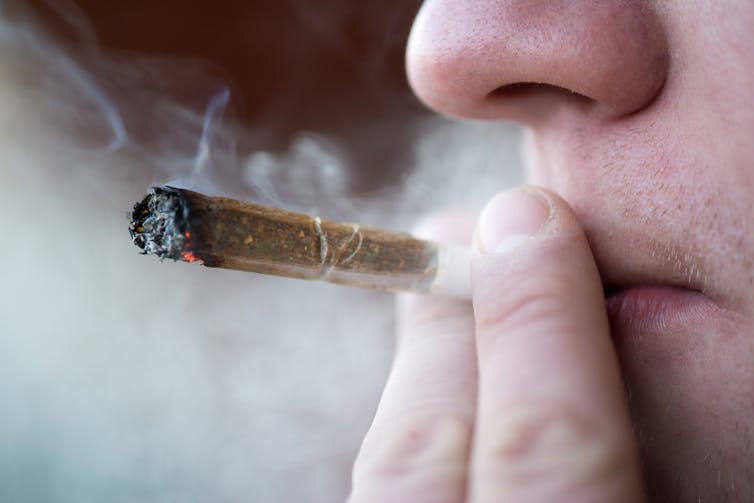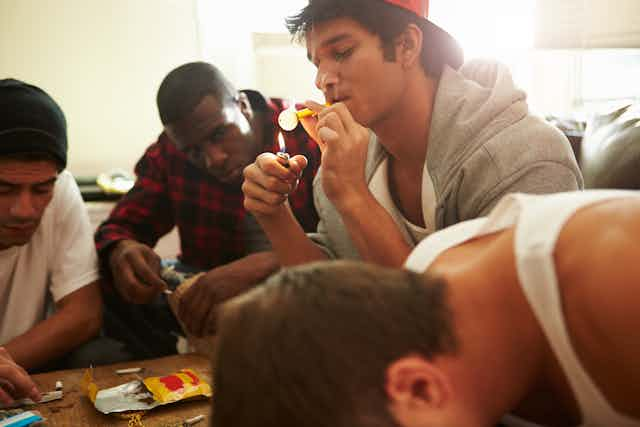Males make up two-thirds of people accessing alcohol and other drug services; 75% of them have been involved in the justice system.
Those with problem drug use also have high rates of mental health problems and backgrounds of contact with child protection. They have much lower levels of educational attainment and employment than their peers.
While poverty or childhood trauma certainly don’t cause substance abuse, they do play a part. But awareness of other social and environmental factors, such as society’s perpetuation of masculinity, are critical to understanding the interconnections between trauma, disadvantage and substance abuse in young men.
The ‘wrong crowd’
I interviewed 35 young males between the ages of 14 and 25 accessing drug treatment services in Victoria. The usual drugs of concern are cannabis, methamphetamine and alcohol.
When asked about what they wanted for their future, the men’s answers were remarkably similar: they wanted a home, job and wife. Traditional ideas of being a provider pervaded their narratives.
Achieving this kind of masculinity is difficult for these young men. Primarily because it necessitates education and employment. Only 9% of those in my study completed school, with most (66%) leaving by the end of year nine.
At a time when 87% of Victorian males are completing their final year of school, lack of formal education is a considerable barrier to employment.

When I asked how they transitioned from school to unemployment, many spoke about falling in with “the wrong crowd”. The description of this group as being wrong showed they felt a deviation from their idea of what young men ought to be doing.
Gerald was acutely aware of the steps to this conception of manhood he had not taken:
I can’t help but compare myself to some of my other friends. Like my other mate, he’s got a trade, he’s paying off a house, he’s got a girlfriend - he’s living the dream pretty much … and I’ve got nothing, and it’s my fault – I am not making excuses. It’s just hard to not feel like an idiot.
At a time in their lives when they were realising there was no place for them in the labour force, the “wrong crowd” offered another variety of masculinity and a place where they felt belonging. Chris described the appeal:
Whether it’s drugs, or fighting, or graffiti, or knives, it’s all just cultures – subcultures. Wherever somebody feels that they fit in, or feel comfortable with that group of people, then they want to do what those people are doing.
Another boy, Pailin, was struggling at school with a poor grasp of English which was not his native tongue. He described his pathway into the wrong crowd as a process of learning to be assertive:
I got picked on because I couldn’t speak properly … It kind of changed me a little bit, because I had to stand up for myself. I wasn’t an aggressive kid or anything you know… But what happened to me… made me more aggressive because I had to stand up for myself… I needed to become one of those cool kids who smoked at school at that’s what I kind of turned into.
Among the wrong crowd, rather than being a worker and provider, men are celebrated for rebellion of these things. From minor delinquency, such as skipping school, through to drug use and violence; the more these young men defied mainstream norms, the more masculine they were perceived to be.
Men are tough
According to my interviews, a key implicit rule in the wrong crowd is to never show any vulnerability: men are tough.

Similarly, a seminal study of street-based crack dealers in East Harlem found the excessive displays of confrontation among men were performances of power from a group who, beyond their housing estates, had no power in the world.
The machismo perpetuated in these subcultures appeared to prevent the men I interviewed from being able to work through their past trauma in ways that didn’t harm them socially.
The middle classes often defer to therapy – formally or informally – but these men did not have spaces where talking, crying and expressing vulnerable emotions would be greeted with compassion. So these were unsurprisingly expressed in other ways.
As Brandon explained:
I get depressed all the time. I get upset over nothing… and then it goes to anger and I blackout and whatever happens, happens … I’ve smashed a lot of things, a few people.
This was similar to Mick:
I’d go to a pub or whatever, pick on someone, wait until they’d fight me. I’d get smashed – I didn’t care; I loved it. I loved being hurt so much ‘cause it relieved all of the tension out of me.
Another common practice of the “wrong crowd” was drug use. Even those who did not initially like drugs learned they were able to anaesthetise their emotions by getting stoned.
Getting out of problem drug use was hard. Criminal records, illiteracy, little formal education and lack of housing or family supports created and exacerbated barriers to entering expected young-adulthood. These barriers seemed insurmountable; in turn, drug use increased.
This cycle is replicated in studies of youth homelessness where it is established that the longer and earlier a person is homeless, the less likely they are to escape homelessness.
Understanding these pathways is integral to any prevention or intervention initiatives.

